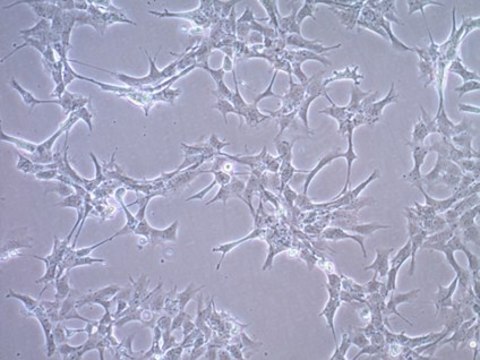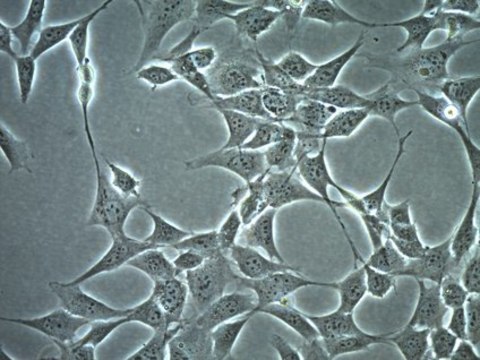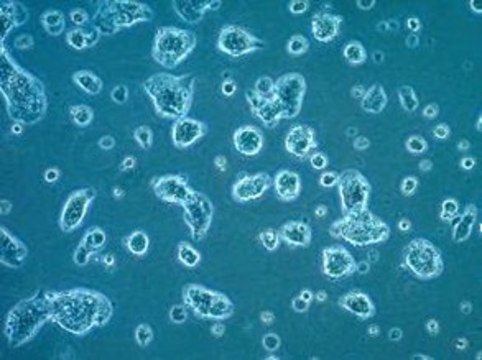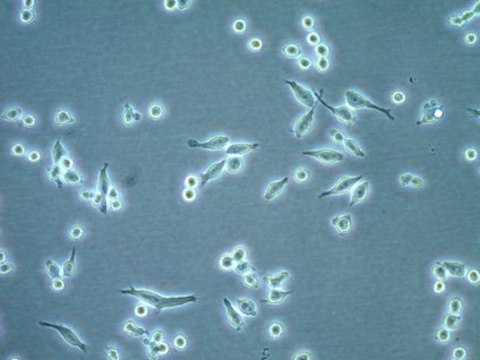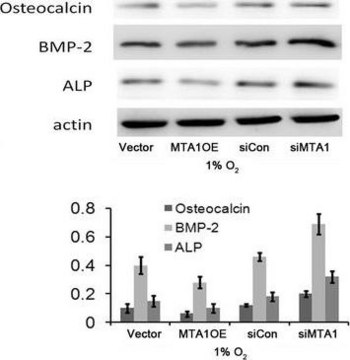SCC188
GN11 Mouse GnRH Neuronal Cell Line
The GN11 mouse neuronal cell line is an immortalized cell line established as a model of GnRH-secreting neurons.
Sign Into View Organizational & Contract Pricing
All Photos(1)
Synonym(s):
GN11 cell line
UNSPSC Code:
41106514
NACRES:
NA.81
Recommended Products
packaging
vial of ≥1X10⁶ cells
technique(s)
cell culture | mammalian: suitable
input
sample type neural cells (lineage)
General description
The GN11 cell line was derived from a transgenic mouse expressing Simian virus-40 (SV40) large T antigen driven by the human GnRH promoter (3). An olfactory bulb tumor from one male GnRH promoter-SV40T fusion-expressing transgenic mouse were dispersed and the GN11 cell line was established from serial dilution and cloning from the primary cells.
Gonadotropin-releasing hormone (GnRH) is important for control of reproduction in all mammals, acting to stimulate the synthesis and secretion of follicle-stimulating hormone and luteinizing hormone from the pituitary gland (1).GnRH is secreted by specialized neurons that migrate from the olfactory bulb to the brain during embryonic development. GnRH neurons are highly sensitive to glucose and insulin, suggestive of their physiological role in sensing the metabolic status in preparation for reproduction (2). Defects in GnRH neuronal function result in subfertility and developmental abnormalities. The scattered distribution and scarcity of GnRH neurons in the brain complicate the in vivo study of these cells and necessitate the utilization of robust in vitro cell models.
The GN11 mouse neuronal cell line is an immortalized cell line established as a model of GnRH-secreting neurons (3). In addition to GnRH expression, GN11 cells display neuron-specific markers including microtubule-associated protein 2 (MAP2) and Tau (4). GN11 cells express insulin receptor (5) and are responsive to steroid hormones (6). The GN11 GnRH-secreting neuronal cell line has proven a valuable system for exploring the cellular mechanisms of neuroendocrine reproductive physiology.
Gonadotropin-releasing hormone (GnRH) is important for control of reproduction in all mammals, acting to stimulate the synthesis and secretion of follicle-stimulating hormone and luteinizing hormone from the pituitary gland (1).GnRH is secreted by specialized neurons that migrate from the olfactory bulb to the brain during embryonic development. GnRH neurons are highly sensitive to glucose and insulin, suggestive of their physiological role in sensing the metabolic status in preparation for reproduction (2). Defects in GnRH neuronal function result in subfertility and developmental abnormalities. The scattered distribution and scarcity of GnRH neurons in the brain complicate the in vivo study of these cells and necessitate the utilization of robust in vitro cell models.
The GN11 mouse neuronal cell line is an immortalized cell line established as a model of GnRH-secreting neurons (3). In addition to GnRH expression, GN11 cells display neuron-specific markers including microtubule-associated protein 2 (MAP2) and Tau (4). GN11 cells express insulin receptor (5) and are responsive to steroid hormones (6). The GN11 GnRH-secreting neuronal cell line has proven a valuable system for exploring the cellular mechanisms of neuroendocrine reproductive physiology.
Application
This product is intended for sale and sold solely to academic institutions for internal academic research use per the terms of the “Academic Use Agreement” as detailed in the product documentation. For information regarding any other use, please contact licensing@emdmillipore.com.
Packaging
≥1X10⁶ cells/vial
Quality
- Each vial contains ≥ 1X10⁶ viable cells.
- Cells are tested negative for infectious diseases by a Mouse Essential CLEAR panel by Charles River Animal Diagnostic Services.
- Cells are verified to be of mouse origin and negative for inter-species contamination from rat, chinese hamster, Golden Syrian hamster, human and non-human primate (NHP) as assessed by a Contamination CLEAR panel by Charles River Animal Diagnostic Services.
- Cells are negative for mycoplasma contamination.
Storage and Stability
Store in liquid nitrogen. The cells can be cultured for at least 10 passages after initial thawing without significantly affecting the cell marker expression and functionality.
Disclaimer
This product contains genetically modified organisms (GMO). Within the EU GMOs are regulated by Directives 2001/18/EC and 2009/41/EC of the European Parliament and of the Council and their national implementation in the member States respectively. This legislation obliges Merck to request certain information about you and the establishment where the GMOs are being handled. Clickhere for Enduser Declaration (EUD) Form.
Unless otherwise stated in our catalog or other company documentation accompanying the product(s), our products are intended for research use only and are not to be used for any other purpose, which includes but is not limited to, unauthorized commercial uses, in vitro diagnostic uses, ex vivo or in vivo therapeutic uses or any type of consumption or application to humans or animals.
Unless otherwise stated in our catalog or other company documentation accompanying the product(s), our products are intended for research use only and are not to be used for any other purpose, which includes but is not limited to, unauthorized commercial uses, in vitro diagnostic uses, ex vivo or in vivo therapeutic uses or any type of consumption or application to humans or animals.
WGK
WGK 2
Flash Point(F)
Not applicable
Flash Point(C)
Not applicable
Regulatory Information
新产品
Certificates of Analysis (COA)
Search for Certificates of Analysis (COA) by entering the products Lot/Batch Number. Lot and Batch Numbers can be found on a product’s label following the words ‘Lot’ or ‘Batch’.
Already Own This Product?
Find documentation for the products that you have recently purchased in the Document Library.
Paolo E Forni et al.
Molecular neurobiology, 46(2), 349-360 (2012-07-10)
Sensory neurons in vertebrates are derived from two embryonic transient cell sources: neural crest (NC) and ectodermal placodes. The placodes are thickenings of ectodermal tissue that are responsible for the formation of cranial ganglia as well as complex sensory organs
S Radovick et al.
Proceedings of the National Academy of Sciences of the United States of America, 88(8), 3402-3406 (1991-04-15)
Gonadotropin-releasing hormone (GnRH) is important in reproduction, although the mechanism of central hypogonadism in humans remains unclear. Because the GnRH neuron originates from the olfactory placode and migrates to the hypothalamus during development, central hypogonadism in humans could be caused
Egr-1 binds the GnRH promoter to mediate the increase in gene expression by insulin
Sara A. DiVall a, Sally Radovick a, Andrew Wolfe b
Molecular and Cellular Endocrinology, 270, 64-72 (2007)
S Zhen et al.
The Journal of biological chemistry, 272(19), 12620-12625 (1997-05-09)
Gonadotropin-releasing hormone (GnRH) is encoded by the proGnRH gene which contains four exons and three introns. In this study, two immortalized GnRH-expressing cell lines (Gn11 and NLT) were characterized. The NLT and Gn11 cells, derived from a same brain tumor
S Radovick et al.
Hormones and behavior, 28(4), 520-529 (1994-12-01)
In order to study the molecular mechanisms involved in the control of GnRH gene expression, the human GnRH gene was cloned and characterized. The gene was expressed in cells obtained from CNS tumors in transgenic mice generated utilizing 1131 bp
Our team of scientists has experience in all areas of research including Life Science, Material Science, Chemical Synthesis, Chromatography, Analytical and many others.
Contact Technical Service